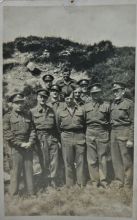In "The Last Ditch", Captain Stuart Edmundson, the first Intelligence Officer for Devon and Cornwall, recalled that he had set up the Patrols in his area before receiving any help from Coleshill. Two subalterns arrived first, shortly before the area was split into two. The rest of the Scout Sections arrived after this. The first Cornwall Intelligence Officer was John Dingley who was posted Scout Section Officer for Cornwall on 15th November 1940, which approximately dates the setting up of these two Scout Sections. Cornwall was originally combined with Devon as an area, so there were only two Scout Sections covering the two counties.
Cornish Patrols came to Porthpean House for the weekend for training.
Most Scout Sections had at least two operational bases, though the location of those in Cornwall is unknown. With the change in headquarters these may have been dug in more than one location.
John Dingley's daughter Anne recalled the soldiers built a galvanised iron shed at the bottom of their field at Polhilsa House, Callington. She recalled it was painted dark green and was always kept securely locked.
| Name | Occupation | Posted from | Until |
|---|---|---|---|
| Lieutenant John Dingley | Bank manager |
15 Nov 1940 | 14 Jun 1941 |
| Lieutenant Robin Williams | Unknown | 1943 | |
| Sergeant Robertson | Poulterer |
Unknown | Unknown |
| Corporal Walter Reginald Durston | Dockyard worker |
09 Nov 1940 | Unknown |
No names are known for the rest of the section. There would have been a sergeant, corporal and 11 other men, including a driver and cook, commanded by a Lieutenant with his own batman-driver. From April 1943 the section would have been reduced in size to around half a dozen men. A single photo sent to John Dingley by the St Dennis Patrol in July 1943 shows some men from the Duke of Cornwall's Light Infantry (DCLI) present at the visit of Major Oxenden from Headquarters at Coleshill House. As they wear the Service Dress cap (a peaked cap not worn by the Home Guard), they are likely members of the Scout Section. All these men have DCLI badges on their caps. They are likely to have been members of the Cornwall Scout Section. The sergeant on the left has an early fighting knife in his right trouser leg, which differs from the more common Fairbairn Sykes knife worn by Group Commander Captain H W Abbiss (second from left).
The Headquarters for the Scout Section is thought to have been initially at Nanstallon near Bodmin, which is the address given in a bank book for Auxiliary Units kept by Captain Dingley.
Lieutenant Williams is known to have stayed at his family’s home, Scorrier House, though it is not clear if this was used for military purposes by Auxiliary Units.
The exact transport for this section is not known. Most Scout Sections had a 15 cwt truck and an Austin 2 seater car for the officer. There were normally issued with bicycles as well.
Anne Barks, the daughter of John Dingley
The Last Ditch, David Lampe
Alwyn Harvey/ Defence of Britain
